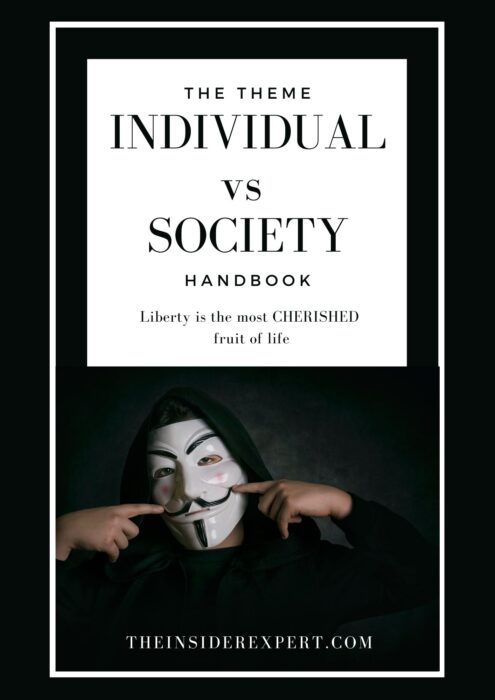SAMPLING FROM: How to Select your Book’s THEME

This is a sampling of the content in How to Select your Book’s THEME (M1-S208)
TOPIC: How to use the INDIVIDUAL vs SOCIETY THEME to empower your readersTHEME
No matter if you’re delving into fiction or sticking with non-fiction, figuring out the theme is pretty much the same across the board. The theme is what brings everything in the narrative together, after all.
In this lesson, we’ll take a closer look at why freedom is considered the most valuable aspect of life and what happens when that freedom is compromised, especially when we think about the theme of the Individual versus Society.
Components of the INDIVIDUAL
-
Personal freedom – The desire to live without interference from authority or social control.
-
Individual identity – The sense of being distinct from others despite collective labels.
-
Self-expression – The act of showing one’s true self through words, art, or behaviour.
-
Autonomy – The ability to make decisions without reliance on outside control.
-
Personal integrity – Staying true to one’s own principles even under pressure.
-
Inner truth – A deep conviction about who one really is.
-
Self-awareness – Recognising one’s own feelings, motives, and actions.
-
Authenticity – Living in alignment with one’s values rather than society’s expectations.
-
Privacy – The right to keep parts of one’s life away from public or institutional scrutiny.
-
Self-determination – Choosing one’s own life path despite external constraints.
-
Personal morality – An ethical code that may differ from prevailing social rules.
-
Independent thought – The courage to form opinions not shaped by group consensus.
-
Belief in personal justice – A conviction that fairness can differ from legal or societal norms.
-
Non-conformity – Choosing to live outside mainstream expectations.
-
Spiritual conviction – Faith or belief that guides choices apart from institutional religion.
-
Loyalty to self over group – Prioritising personal needs above collective demands.
-
Dissent – Open disagreement with accepted norms or authority.
-
Intuition – Trusting inner instincts rather than external rules.
-
Individual ethics – A unique moral framework shaped by personal experience.
-
Private conscience – The inner voice guiding right and wrong decisions.
- Fear of isolation – Worry that independence may result in social rejection.
- Desire for acceptance – A longing to be recognised by society while remaining individual.
- Pride in independence – A sense of accomplishment in resisting conformity.
- Shame of exclusion – Feeling diminished when rejected by the group.
- Courage to resist – Strength to oppose authority or crowd pressure.
- Loneliness – The emotional cost of being apart from society.
- Yearning for belonging – The pull to reconcile individuality with community.
- Inner conflict – The struggle between personal belief and social approval.
- Emotional resilience – The capacity to withstand criticism or rejection.
- Personal fulfilment – The deep satisfaction of living according to one’s truth.
- Breaking rules – Deliberately stepping outside society’s legal or moral boundaries.
- Whistleblowing – Exposing corruption or wrongdoing despite personal risk.
- Acts of rebellion – Protesting against authority or oppressive systems.
- Creativity against conformity – Producing original work in the face of conventional norms.
- Pursuing dreams despite pressure – Following passion regardless of society’s disapproval.
- Speaking truth to power – Confronting authority with honesty and conviction.
- Civil disobedience – Peacefully refusing to obey unjust laws.
- Choosing solitude – Withdrawing from society to preserve individuality.
- Defying expectations – Refusing to conform to roles imposed by society.
- Sacrificing self for personal values – Accepting harm or loss for the sake of principle.
-
The outsider – One who never feels they belong within society.
-
The innovator – The individual who introduces new ideas society resists at first.
-
The scapegoat – A person society blames to preserve its stability.
-
The visionary – One who sees a better path beyond social limits.
-
The misfit – Someone who doesn’t align with expected norms.
-
The martyr – A person who suffers for their principles.
-
The rebel – A figure who actively challenges social restrictions.
-
The critic – Someone who questions and analyses societal values.
-
The pioneer – An individual who steps into unknown paths before others dare.
-
The survivor – One who endures society’s rejection or oppression.
Components of the SOCIETY
- Government – The state’s authority to regulate individual behaviour.
- Law and order – Legal structures that define acceptable conduct.
- Religious institutions – Organised faiths enforcing moral and social codes.
- Schools and education systems – Institutions shaping minds to fit societal norms.
- Military service – Duty imposed on individuals for collective security.
- Political ideologies – Systems of thought guiding society’s values and rules.
- Economic systems – Structures that regulate wealth, labour, and opportunity.
- Justice system – Courts and laws punishing those who resist norms.
- Police and surveillance – Mechanisms to monitor and control behaviour.
- State power – Centralised authority that can override individual choice.
- Tradition – Customs carried down to maintain cultural continuity.
- Collective morality – Shared standards of right and wrong.
- Cultural expectations – Unwritten rules for behaviour in groups.
- Social etiquette – Manners dictating polite conduct.
- Religious norms – Faith-based rules shaping daily life.
- Gender roles – Social expectations based on sex and identity.
- Class structures – Hierarchies that place individuals in fixed positions.
- Cultural identity – A sense of belonging to a larger heritage.
- Ethnic heritage – Collective identity shaped by ancestry.
- Shared history – Narratives binding people into a single group.
-
Conformity – Expectation that individuals act like the majority.
-
Groupthink – Suppression of dissent to preserve group harmony.
-
Peer pressure – Direct influence from immediate social circles.
-
Stigma – Marking individuals as outsiders for breaking rules.
-
Censorship – Blocking ideas that challenge collective authority.
-
Public opinion – Majority attitudes that influence behaviour.
-
Fear of exclusion – The threat of being ostracised.
-
Gossip and reputation – Informal policing through community talk.
-
Collective values – Widely held beliefs considered inviolable.
-
“The greater good” – Sacrificing individuals for society’s benefit.
- Security – Protecting the whole from threats.
- Stability – Ensuring predictable continuity of life.
- Public health – Managing disease and well-being collectively.
- Order – Maintaining peace through regulation.
- Tradition over change – Preference for continuity over disruption.
- Shared responsibility – Expectation that all contribute to community.
- Economic prosperity – Growth framed as a communal priority.
- Preservation of hierarchy – Keeping existing power structures intact.
- Maintaining peace – Avoiding chaos at the cost of individual freedom.
- National unity – Suppressing difference to keep cohesion.
- The judge – Society’s arbiter of acceptable behaviour.
- The censor – Gatekeeper who silences disruptive voices.
- The oppressor – Enforcer of rigid conformity.
- The guardian of norms – Preserver of traditions and order.
- The mob – Collective acting without reason against outsiders.
- The bystander – Society’s silent majority, allowing norms to persist.
- The benefactor – Provider of support, yet within controlled limits.
- The reformer (as collective voice) – Society’s own push for gradual change.
- The punisher – Collective will that sanctions rebels.
- The protector – Society shielding individuals, but demanding obedience in return.
Questions to Ask Yourself that May Help

You know, the whole idea of Individual versus Society is such a classic theme in literature and cultural studies. What really makes it interesting is the kind of questions that writers are ready to explore.
FOR FICTION WRITERS
When you ask these questions, it really helps make the conflict between your characters and society feel more layered and believable. It stops characters from being one-dimensional, letting them deal with real pressures, moral dilemmas, and emotional costs that reflect what readers go through themselves. When fiction writers dig into the reasons behind actions, the stakes involved, and the outcomes, they craft stories that resonate and make you think even after you’ve turned the last page.
FOR NON-FICTION WRITERS
Asking questions is super important, but for different reasons. It keeps their work grounded in fairness, accuracy, and context, which helps them steer clear of oversimplifications when talking about real people and the societies that challenged them. These questions show how sources can be biassed, point out the intricate cultural and historical influences at play, and bring to light the legacies of those who stood against conformity. By doing this, non-fiction writers create stories that are not only trustworthy but also thought-provoking, helping readers grasp the bigger picture of these conflicts.
Questions really are the key to getting deeper in both forms. They take the theme from just a surface conflict and turn it into a deep dive into freedom, justice, belonging, and what it costs to speak out—making the writer’s work not only more layered but also more relatable for readers today.
Character & Identity
-
Who is the individual at the centre of the conflict?
-
What makes this character different from society around them?
-
What personal values or beliefs set them apart?
-
Does the character long to belong, or embrace being an outsider?
-
How do they define their sense of self in relation to society?
Motivation & Stakes
-
What does the character want that society denies them?
-
What will they risk to maintain their individuality?
-
How does society punish or reward their choices?
-
What personal sacrifices must they make?
-
What is at stake if they conform?
Society as Opponent
-
What is the society’s main expectation or demand?
-
Which institution represents the pressure (school, church, state, family)?
-
How does society justify suppressing the individual?
-
Does the society fear change, chaos, or exposure?
-
Are its values stable or beginning to crack?
Conflict & Tension
-
How does the clash first appear in the story?
-
Is the conflict open (law, trial, protest) or hidden (whispers, judgement)?
-
What forms of social pressure are applied—shame, gossip, punishment?
-
Who supports the character, and who opposes them?
-
How does the individual resist—silently, rebelliously, creatively?
Plot Development
-
What smaller battles build towards the main confrontation?
-
Does the character compromise, or stay defiant?
-
What role do secrets and revelations play in the conflict?
-
How does society escalate its resistance?
-
Where is the turning point—when the character cannot go back?
Resolution & Consequences
-
Does the character ultimately win or lose?
-
What personal cost do they pay for resistance?
-
Does society change because of them, or remain rigid?
-
Does the ending bring reconciliation, exile, or tragedy?
-
How does the outcome reflect the theme of freedom versus control?
Symbols & Themes
-
What object or symbol represents individuality?
-
What symbol represents society’s control?
-
How does setting embody the tension (claustrophobic city, small village, regimented school)?
-
What role does tradition play in upholding society’s power?
-
How is justice portrayed—fair or biased?
Perspective & Reader Engagement
-
Which narrative voice best shows the tension (first person, omniscient, unreliable narrator)?
-
Should the reader sympathise more with the individual or society?
-
How do you create moral ambiguity in the conflict?
-
How do readers recognise this conflict in their own lives?
-
Does the story provoke readers to question their own conformity?
Genre & Style
-
Is the theme explored through dystopia, historical fiction, or contemporary drama?
-
How does genre change the form of society’s pressure?
-
Can humour, satire, or irony sharpen the critique?
-
How does pacing reflect the character’s struggle?
-
Does dialogue highlight individual versus collective voices?
Broader Meaning
-
What universal truth does the story reveal about people and society?
-
How does this conflict echo real history or modern politics?
-
Is the individual’s fight part of a wider movement?
-
Is the story a warning, celebration, or lament?
-
What lasting impression of “Individual vs Society” do you want readers to carry away?
Purpose & Angle
-
What aspect of the individual vs society conflict do I want to explore?
-
Am I documenting a single person’s struggle or a broader trend?
-
Is my focus historical, cultural, political, or psychological?
-
What is the core question I want the reader to consider?
-
Does my work aim to inform, persuade, or challenge?
Case Selection
-
Which individuals best illustrate this theme?
-
Are they famous figures, or ordinary people in extraordinary situations?
-
What society or institution opposed them?
-
Why is their conflict relevant now?
-
How representative are they of others in similar positions?
Research & Evidence
-
What primary sources (letters, diaries, legal documents) are available?
-
Which secondary sources provide analysis?
-
How do I account for bias in the records?
-
What voices are missing from the story?
-
How do I verify accuracy when accounts conflict?
Society’s Side
-
What rules, laws, or traditions did society enforce?
-
What was the stated reason for resisting the individual?
-
How did collective fears shape society’s response?
-
Was society protecting order, morality, or self-interest?
-
Did society eventually admit wrongdoing?
The Individual’s Side
-
What personal convictions drove the individual?
-
How did they articulate their resistance?
-
Did they act alone, or lead a movement?
-
How did they pay for their choices—socially, financially, or physically?
-
What legacy did they leave?
Broader Patterns
-
How does this case compare with similar ones across history?
-
Are there recurring traits among individuals who resist society?
-
How do societies typically treat dissenters?
-
What conditions make resistance more likely?
-
Do societies eventually absorb rebels into mainstream culture?
Ethical Considerations
-
Am I portraying the individual with fairness and accuracy?
-
Am I treating victims or oppressed groups respectfully?
-
Do I avoid romanticising rebellion without critique?
-
Am I acknowledging the complexity of both sides?
-
What responsibility do I have to modern readers?
Writing & Presentation
-
What structure best conveys the theme—chronological, thematic, case-study?
-
How much background context does the reader need?
-
How do I balance narrative storytelling with factual analysis?
-
Should I use a detached tone or a more impassioned voice?
-
How do I keep readers emotionally invested?
Reader Engagement
-
How does this conflict connect to current events?
-
What lessons can readers draw about justice and freedom?
-
Does this story challenge readers’ own conformity?
-
Should the reader admire, pity, or question the individual?
-
How can I present society’s side without excusing harm?
Broader Meaning
-
What does this case reveal about the balance of power?
-
Is society’s resistance to change inevitable or avoidable?
-
How fragile is individuality under pressure?
-
What universal pattern does this conflict highlight?
-
What call to action or reflection should readers take away?
PDF Workbook Instructions

Download your PDF workbook and save it to your a folder you have created on your computer specifically for saving your ideas, so you can refer to it again and again.
This interactive PDF workbook provides a convenient platform for directly typing and organising your ideas.
Open the interactive PDF workbook in a PDF viewer and type your answers in.
You can print your PDF workbook out (be sure to select· scale size to fit your printer setting) and place them into your ideas binder.
Open the interactive PDF workbook in a PDF viewer and type your answers in.
Want More
Do you want to know more now that you’ve tried the samples? Do you want to learn something new and be able to identify the emotion or action you want your reader to experience after reading your book?
How to Identify Your Writing’s Target Audience (M1-S207)
If you’re searching for a more focused learning experience, this could be the appropriate solution. A theme is an important tool in any writer’s toolkit because it creates an emotional connection with your readers, attracting and then retaining them.
This course is designed for all authors who want to learn more about selecting the best theme for their target audience. With 17 lessons, you’ll be able to learn at your own pace and review the content as many times as necessary to completely grasp the ideas.
This course includes fantastic interactive handbooks on the following themes:
- The Circle of Life
- Coming of Age
- Crime Doesn’t Pay
- Death
- Good vs Evil
- Judgement
- Love Conquers All
- Man Struggles Against Nature
- Overcoming the Odds
- Power of Friendship
- Rags to Riches
- Spiritual Enlightenment.
